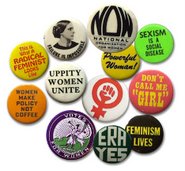Take Back the Night Part II
I know it's taken me a while to post the other half of this one so here it is. This is the "hard news" story I wrote about the rally at CSUN. One of the things that I've noticed about journalism thus far, is that "hard news" is supposed to be considered more challenging, more real. Feature stories seem to have a reputation for being fluff oe soft. This pisses me off.
I would much rather read a Wall Street Journal style feature story that a typical inverted pyramid who-what-when-where-why news story any day. I also find it to be much more fun to write a feature story. Knowing what the news is is important, but I also want to know who it affects. How does it affect them and why? Putting an individual, human take on a story does not make it weaker. I think it strengthens it and can have much more impact.
One way isn't really better or more important than the other, but I hate how feature stories are dismissed by some people. The real news-men cover the real news and the women write fluffy little feature pieces. Ugh.
That said, here's my "real" news story about the Take Back the Night rally. I admit, I had a much more interesting time writing the feature piece below, but this was challenging as well because I had to distill all the information into something readable.
(Warning: there is some explicit language at the end that could be triggering for some readers.)
Here you go:

Over 250 CSUN students attended the Take Back the Night rally at Plaza del Sol Thursday night to raise awareness about violence against women and offer support to victims of domestic violence.
Domestic violence, rape and other forms of sexual abuse are still common occurrences but are rarely talked about in public. Take Back the Night rallies have been organized around the country for more than 20 years in an effort to educate the public about the issue.
Domestic violence, rape and other forms of sexual abuse are still common occurrences but are rarely talked about in public. Take Back the Night rallies have been organized around the country for more than 20 years in an effort to educate the public about the issue.
CSUN alumna, Alexis Lawrence, founder of the university’s first Take Back the Night rally five years ago, opened the event. “Every eight minutes a woman is raped according to R.A.I.N.N. Every two minutes a woman is sexually assaulted,” she said. “That’s appalling. I’m here because we are going to take back the night. This is our night to take it back.”
The evening continued with short speeches by representatives of campus and community groups. Mark Stevens of University Counseling Services, Professor Shira Brown from the Women’s Studies Department and Peggy Raina director of Peace Over Violence spoke, read poetry and offered their thoughts about ways to end the violence.
“Why does rape exist?” Stevens asked. “For one main reason, because it can. It is essential for us, as men, to break the code of silence that we have been taught to uphold and speak out against rape,” he said.
The plaza was ringed with tables set up by different groups such as The Valley Trauma Center, the CSUN V-Day club, the CSUN Lesbian, Gay, Bisexual and Transgender Alliance, the University Counseling Services and Project D.A.T.E.
Behind the tables a clothes line hung with t-shirts provided a back drop for the speeches and activities. The shirts are part of the Clothesline Project, an art project where women who have experienced violence can express their emotions by decorating a t-shirt and displaying it as part of the larger piece. One small, pink shirt read, “It’s not my fault” in red fabric paint. A larger, yellow shirt had the words “No means no!” scrawled across it in blue paint.
Once the speeches had concluded, participants were given candles by volunteers of the campus Women’s Resource and Research Center and hand-painted posters to carry in an evening march across campus. They chanted “Two, four, six, eight, no more violence, no more rape!”, as they walked past the Oviatt Library and the Arbor Court. Others chanted “Join together, free our lives, we will not be victimized.” Their signs were emblazoned with slogans such as “My body my right” and simply, “I won’t be afraid.”
 When the boisterous group reached the corner of Etiwanda Ave. and North University Dr. they fell silent and continued their walk to recognize victims of domestic violence who have not survived. They ended the march in front of the Chicano/a House where a small stage had been set up on the front lawn with a microphone and speakers. The approximately 200 marchers extinguished their candles and gathered together, sitting on metal, folding chairs and blankets on the ground to share their stories and support one another.
When the boisterous group reached the corner of Etiwanda Ave. and North University Dr. they fell silent and continued their walk to recognize victims of domestic violence who have not survived. They ended the march in front of the Chicano/a House where a small stage had been set up on the front lawn with a microphone and speakers. The approximately 200 marchers extinguished their candles and gathered together, sitting on metal, folding chairs and blankets on the ground to share their stories and support one another. Stephanie Montes, student director of The Women’s Resource and Research Center and the lead organizer of the event, thanked the crowd and encouraged them to support the group at an upcoming meeting with the University Provost’s office. The Women’s Resource and Research Center is seeking funds to rebuild their house which was gutted by an electrical fire on Dec. 18, 2007 following a power surge that occurred the same night.
The rally concluded with almost two hours of people getting up onstage and telling their stories of surviving violence, some through tears and shaking voices, many with the support of friends standing with them. Women and men got up over and over again and told variations of the same story. “He pinned my arms over my head and penetrated me,” said one woman while her friends stood beside her.
 “He hit me over and over again,” said a young man of his father’s abuse.
“He hit me over and over again,” said a young man of his father’s abuse. Lawrence told the group why she decided to share her story five years ago and start Take Back the Night at CSUN. “Some people call it a transformation from victim to survivor, I just call it surviving.”



No comments:
Post a Comment